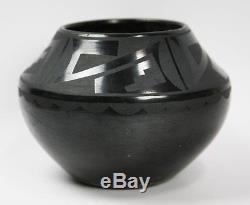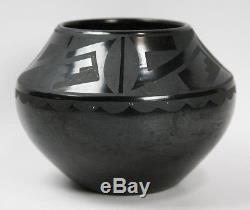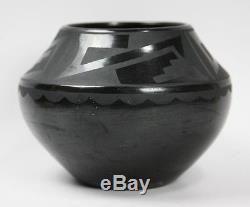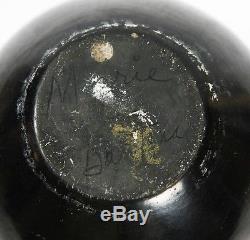Maria Martinez and Santana Martinez San Ildefonso Black on Black Jar, c. 1940





6.25" x 7.5". Original owner acquired this directly from Maria Martinez at San Ildefonso. Located 23 miles north of Santa Fe, New Mexico, San Ildefonso pueblo has long been considered the epicenter for the pueblo pottery movement.
This is the birthplace of Maria Martinez and the newer form of San Ildefonso pottery. The famous black-on-black pottery, once a token tourist piece, now graces the highest mantles and shelves of museums worldwide. A growing interest in Native American by anthropologists and archeologists of the Smithsonian Institution led to the excavation of Avanyu black-on-black pottery and subsequent attempt to emulate the pottery by Maria Martinez, which spawned a new form of firing pottery. Maria Martinez and her husband Julian did more than discover a method of firing pottery in a low oxygen environment to create a blackened, opulent pottery. They transformed a pueblo and created a movement that benefited Native Americans and spawned an art form worthy of worldwide recognition.
Part of the uniqueness of San Ildefonso pottery is the clay that is used, which comes from their reservation. Dried clay and volcanic ash are collected yearly from selected locations throughout the reservation, and later combined with water in small batches. The clay from each pueblo has its own mineral composition, allowing for rich differences in texture and color.
The watery clay slip that is used on the black wares, for example, has a rich iron content that turns black when fired in a particular way. After a batch of clay is mixed and has set for a few days, a "pancake" of clay is formed and pressed into a puki, beginning the process of building a pot. The puki is a bowl-shaped form that supports the bottom of the pot as it is being built.
Most commonly, pots are formed with a coil technique, in which long snake-shaped coils are circled around the base of the pot and blended together to create the walls of the vessel. Similar to most pueblo artists, regardless of pueblo, it was (and still is) a'family affair' in the creating of pottery. If only in the collecting of materials, family members contribute at all stages. Maria's pottery has numerous signatures of people who helped with the decoration.
The making of San Ildefonso pottery is a laborious task requiring great skill. From the gathering of the clay, forming of the vessel, painting, and finally, the firing, the potter may have vested 15-50 hours per vessel. Medicine Man Gallery has been in the Antique Native American art business for 23 years. We have one of the largest inventories of Antique Native American art for sale in the country, offering. Navajo Rugs and Blankets, American Pueblo Pottery, Indian Baskets, Hopi Kachinas, Old Pawn Jewelry, Contemporary Native American Jewelry, and Native American Beadwork, as well as Ethnographic Art, Western Americana and Art of the West. The item "Maria Martinez and Santana Martinez San Ildefonso Black on Black Jar, c. 1940" is in sale since Tuesday, July 05, 2016. This item is in the category "Collectibles\Cultures & Ethnicities\Native American\ US\1935-Now\Pottery". The seller is "medicinemangallerytucson" and is located in Tucson, Arizona. This item can be shipped to United States.- Origin: San Ildfonso
- Artisan: Maria Martinez
- Tribal Affiliation: San Ildefonso

